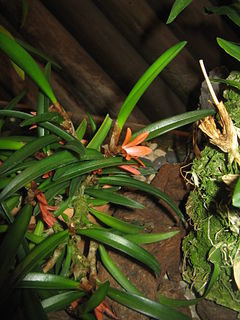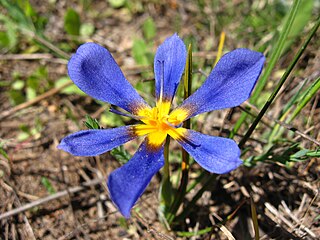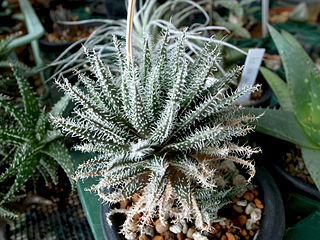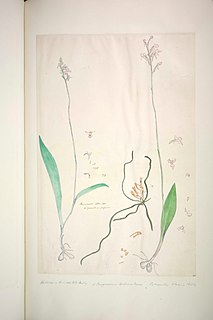
Gossypium is a genus of flowering plants in the tribe Gossypieae of the mallow family, Malvaceae, from which cotton is harvested. It is native to tropical and subtropical regions of the Old and New Worlds. There are about 50 Gossypium species, making it the largest genus in the tribe Gossypieae, and new species continue to be discovered. The name of the genus is derived from the Arabic word goz, which refers to a soft substance.

Birbal Sahni FRS was an Indian paleobotanist who studied the fossils of the Indian subcontinent. He also took an interest in geology and archaeology. He founded what is now the Birbal Sahni Institute of Palaeobotany at Lucknow in 1946. His major contributions were in the study of the fossil plants of India and in plant evolution. He was also involved in the establishment of Indian science education and served as the President of the National Academy of Sciences, India and as an Honorary President of the International Botanical Congress, Stockholm.

Kai Larsen was a Danish botanist.

Crassocephalum is a genus the common names of whose members include ragleaf, thickhead, and bologi. Several species are raised as leaf vegetables and used for medicine, especially in West Africa. Similar to Senecio, but differing in never having ray florets. A calyculus of short bracts is present. The genus is typically thistle-like in appearance, but all parts are soft and not spiny.

Otto Stapf FRS was an Austrian born botanist and taxonomist, the son of Joseph Stapf, who worked in the Hallstatt salt-mines. He grew up in Hallstatt and later published about the archaeological plant remains from the Late Bronze- and Iron Age mines that had been uncovered by his father.

William Brian Keith Holmes is an Australian palaeobotanist, best known for his work "Fructifications of Glossopteris" (1974), published in the Proceedings of the Linnean Society of New South Wales. Despite having received no formal training in palaeontology, he has become an important contributor in the field and has described some 80 new species, mostly from 2 quarries at Nymboida in northern New South Wales, and situated on the Triassic.
Harold St. John was a professor of botany at the University of Hawaiʻi at Mānoa from 1929 to 1958. A prolific specialist in field botany and systematics, he is credited with discovering about 500 new species of Pandanus, along with many other species, especially in the Pacific Islands.

Ceratostylis is a genus of orchids with more than 140 species distributed in China, India, Southeast Asia, New Guinea, the Philippines, and Melanesia.

Calydorea is a small genus of perennial, herbaceous and bulbous plants in the family Iridaceae native to Mexico and South America. The plants in the genus are small with tunicated bulbs. The flowers are light blue, violet, white, or yellow, depending on the species, of which there are around twenty. Taxonomists considered that the already known genera Salpingostylis, Cardiostigma, Catila and Itysa are not enough different from each other to justify their taxonomic segregation and, for this reason, all of them are now included in Calydorea.

Gaudinia is a genus of Mediterranean plants in the grass family.

Empetrum rubrum, known as red crowberry or diddle-dee, is a species of plant in the family Ericaceae with a distributional range in Chile from Talca (35°S) to Cape Horn (55°S); in areas of adjacent Argentina; in the Falkland Islands; and in Tristan da Cunha. One of its northernmost natural growing places is Laguna del Maule. In Chile this species often grows in high altitude areas close to the tree line and can tolerate alpine conditions such as strong winds and high sun exposure. In the Falkland Islands it is the dominant species across large areas of lowland and upland dwarf shrub heath, and is referenced in the islands' unofficial national anthem. Its fruits are edible.
Cyperus elegans, the royal flatsedge, is a sedge species in the genus Cyperus from Central and South America.

Cynorkis gibbosa is an orchid species in the genus Cynorkis, endemic to forest edges and shaded rocks at altitudes of 600–1500 meters in Madagascar. Its flowers are salmon-pink or red, and about 35 mm in length. Found in Madagascar on shady granite rocks, on steep banks, seepage areas, along streams and at forest edges at elevations of 600 to 2000 meters as a small to medium-sized, warm to cool growing terrestrial herb with several elongated, villous tubers giving rise to a solitary, radical, oblong-lanceolate, purple maculate leaf that is shortly attenuate at both ends and amplexiculate basally that blooms in the mid spring through fall on a bristly granular, sometimes glabrous, densely many [10 to 40] flowered, subcorymbiform inflorescence carrying 2 to 3 distant, cauline sheaths and having 10 mostly simultaneous flowers at any one time.
Cousinia multiloba is a species of flowering plants in the tribe Cynareae. It is found in Iran and Afghanistan.
Chellapilla Venkata Rao (1910–1971) was an Indian botanist.

Agelaea pentagyna is a species of flowering plant in the family Connaraceae. It is found in Africa.

Aloe haworthioides is a species of flowering plant in the Asphodelaceae family. It native to Madagascar. This Aloe is named for its leaves covered with soft spines and thus its resemblance to Haworthia species. A small species, it grows in stemless, clumping offsets and sports orange, highly fragrant flowers.
Herbert Fuller Wernham was a British botanist, who from 1909 to 1929 worked at the British Museum, as an assistant in the Botany department. From 1911 to 1921 he published extensively on tropical plants and many genera, retiring in 1921 due to ill health (alcoholism).
Kuhlmanniodendron is a genus of flowering plants belonging to the family Achariaceae.

William Deans Cowan was a Scottish naturalist. He was a member of the London Missionary Society who was sent to Madagascar (1874-1881), where he taught Malagasy students at Fianarantsoa.He was an authoritive collector of natural history material including lemurs, birds, reptiles, molluscs and insects that were sent to the zoology department of the British Museum under Albert Günther. Much of his plant collection, is also held by that institutions herbarium then under William Carruthers.He also collected insects for John Obadiah Westwood, birds for Alfred Newton and orchids for Henry Nicholas Ridley He was a Member of the Royal Geographic Society.













